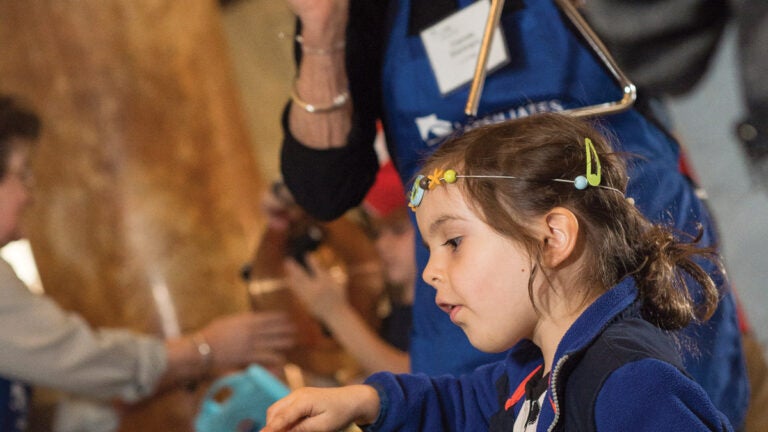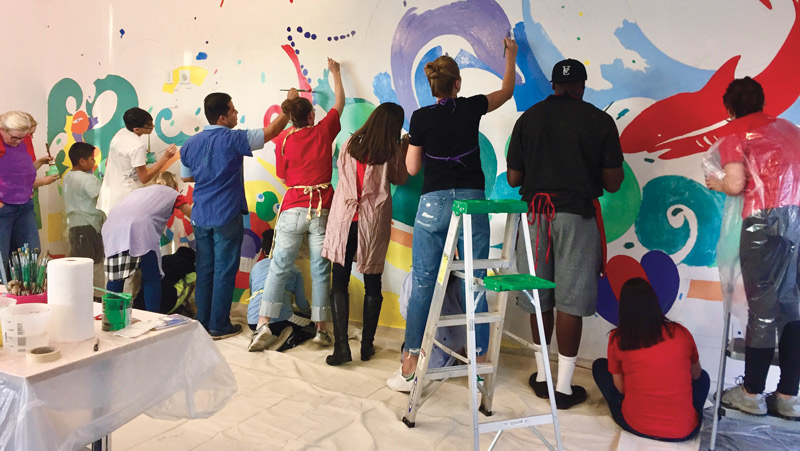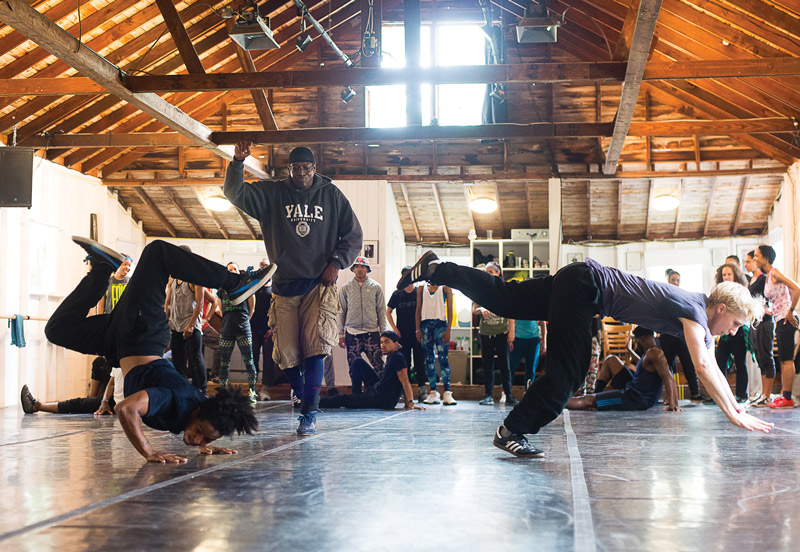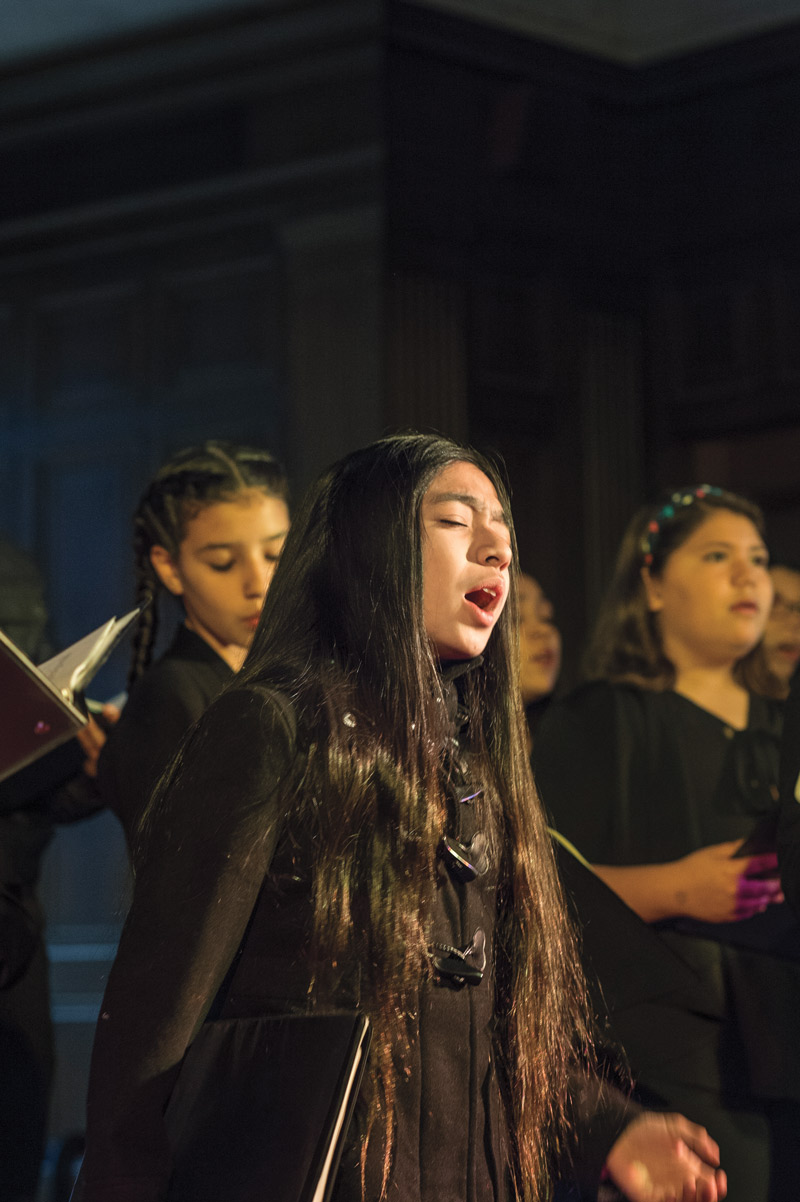
Artists from USC and the community perform as part of Classical KUSC and Classical KDFC Kids Discovery Days. The events introduce children to the arts, including live music. (Photo/Peter Howard)
The Trojans Bringing Arts Education Back to Kids and Schools
If you think arts education has vanished from schools and neighborhoods, these Trojans have some news for you.
Arts education in public schools is dead. May it rest in peace.
Hang on, says Mark Slavkin ’83, MA ’86, director of education at Wallis Annenberg Center for the Performing Arts in Beverly Hills. Slavkin says we’ve been mourning this loss for decades—but our grief may be misplaced.
“I think if we were writing the story in 1999 or 2000, that would be a better premise,” he says. “Since then, there’s been a resurgence and reinvestment in arts education across L.A. County.”
Slavkin should know. After graduating from USC with a master’s degree in political science and then serving in government, he sat on the Los Angeles Unified School District Board of Education for eight years. He also worked at the Getty Education Institute for the Arts and as vice president of education at The Music Center. In other words, he has watched the rise of arts education—and advocated for it—from the front row.
Many of USC’s alumni and faculty have answered the call, bringing their distinct skill sets and personal passions to underserved communities—changing lives with art.
For a long time, funding and resources for the arts in California public schools languished, he acknowledges, especially after the 1978 passage of Proposition 13, which limited increases in property taxes. “Lots of things suffered,” Slavkin says. Schools ended up with “large class size, no counselors, no librarians, too few nurses, etc. The arts have been caught up in that inadequate funding challenge along with everything else.”
But overall, he says, “we’ve been in a pretty consistent upswing since early 2000, when Los Angeles Unified School District adopted an arts plan.”
Nationally, much attention has focused on boosting children’s math and science skills. But some say creativity and innovation are getting lost in the emphasis on STEM (science, technology, engineering and math), so they advocate putting an A—for arts—into the mix: Teach STEAM, not just STEM.
Today Slavkin is part of a county-wide initiative working with almost 70 other school districts that have recommitted to investing in the arts and are taking steps—each in its own way—to expand arts programming.
But is it sufficient? “I think the point that there’s not enough will always be true,” he says. “There will always be a need for more, and more opportunities for kids.”
That’s where many of USC’s alumni and faculty have answered the call, bringing their distinct skill sets and personal passions to underserved communities—changing lives with art.
EARLY START
Vince Womack MMED ’97 and Bobbie Rich ’02 both were surrounded by the arts since they were children. But they’ve seen that many kids don’t have that chance—neither at home nor in school. Womack is music director at James A. Foshay Learning Center, a K-12 school in south L.A. (and part of the USC Family of Schools). His musical confidence was buoyed by a mother and older brothers who played, and he strives to give that confidence to his students.

“A lot of students, when they get into a music program, don’t have a parent or a brother or an uncle, someone who did anything in music,” he says. “So the whole ‘I believe I can’ isn’t there. They may have a lot of ‘I’d like to,’ but I think it’s the self-belief that really drives one through the difficult times.”
His approach includes being honest with students that their relationship with an instrument can be moody: It feels good today, but tomorrow it can feel like pulling teeth. “I try and surround them with different kinds of music experiences—because it’s easy to be a pop music aficionado, but that doesn’t necessarily feed into you nurturing that individual thing that you are,” he says.
Lack of funding can kill an arts program, Womack says, which is why he seeks sponsors and partnerships, including the Mr. Holland’s Opus Foundation, the Harmony Project, Exploring the Arts and the Los Angeles Philharmonic.
Based in Santa Monica, Bobbie Rich uses the painting mastery she developed at the USC Roski School of Art and Design to stoke the creativity of kids across Los Angeles, from low-income housing developments and Boys & Girls Clubs to high-end bedroom communities.
“I work to create opportunities to connect my students to each other and to different nonprofit events, so that they have the benefit of escaping their bubble while doing good works, like painting murals or putting together care packages for less-fortunate people,” Rich says.
Rich minored in communication and graphic arts at USC and landed a job in the field through a school internship. That experience taught her that she couldn’t work in an office, she laughs. So she set out as a freelance artist. “I was able to utilize tools that I learned at Roski in graphic design, and also in advertising and business, to advertise myself. I’m a one-person shop.”
As a child who moved around the country every few years, Rich says she always had access to arts education in public schools. But she knows that’s not the case for a lot of kids today.
“Most of the kids have very limited art,” she says. “Even in high-end private schools, many only have art once a week. For other kids, sometimes once a month or every two months, parents will come in and teach an art project.” Parents often reach out to her for help. Even if finances are tight, arts remain a priority for many parents and their children, she says.
DANCE’S LIFE LESSONS
As professors at the USC Kaufman School of Dance, Moncell Durden and Tiffany Bong are raising the bar for university-level dance education. But they’re also sparking a passion for dance in children at a young age.
Durden grew up in Harrisburg, Pennsylvania, and in the early 2000s he taught and choreographed at The Village of Arts and Humanities in north Philadelphia. The program focused on the needs and interests of the community, including teaching children.

“They had African dance class, and they brought me in as a hip-hop instructor,” he says. “That got me interested in using dance to connect particularly with African-American kids, getting them to understand the richness of their cultural heritage, but also understanding life practice through the lens of dance.”
Durden’s love for music began as an infant, when his dad installed speakers over his crib and piped in jazz and classical music, and he’s poured himself into studying dance through the prisms of neuropsychology, anthropology, linguistics and ethnomusicology.
“For me, teaching dance has never really been about dance,” he says. “If I’m teaching movement, forms and such to a community that creates those, it is getting them to investigate deeper into where they come from, why they come from. My focus is knowing your why from your what.”
In 2010, Durden founded Intangible Roots, a dance group “created to look at the intangible identities of movement, the things that you can’t quite put your finger on,” he says. He’s working on a documentary, Everything Remains Raw, and a certification program for a new teaching method he calls BEATS (short for body, emotion, attitude, time and space) designed to help people learn how to teach social dances.
Fellow USC Kaufman dance lecturer Bong has an out-reach organization of her own: UniverSOUL Hip-Hop. Today it’s in 50 elementary schools, but the idea for it began back when she was 10 and living in San Francisco.

“I went to a more traditional Irish Catholic private school, and there wasn’t really much arts at all,” she says. “When I was in the sixth grade, there was a performance that came to our school, and it was like a timeline of dance. The last 10 minutes was the first time I ever heard hip-hop music and saw hip-hop dance, and that moment literally changed my life. I was sitting in the second-to-last row, no idea what was going on up until the moment [when] I saw the entire school just come to life through the music and the dance. And it just activated me.”
When she got to high school, there was no hip-hop program—so this shy, introverted 16-year-old built her own. After majoring in dance and psychology at Santa Clara University, she joined the nonprofit organization Culture Shock Los Angeles and developed its education and outreach programs.
“I started to realize that I had a deep love for teaching and education,” she says, “and that’s when I built my own company, UniverSOUL Hip-Hop. We actually gear most of our programs to sixth-grade level. It’s a great age for students to really explore identity, culture, heritage—and a sense of body awareness and respect for themselves and each other, and all the social elements that you really see come to life in hip-hop.
“I’m pretty much that dancer that I saw when I was in the sixth grade.”
BUILDING A PIPELINE
At the USC Thornton School of Music, Peter Webster is envisioning the future of music education. USC Thornton Dean Robert Cutietta invited the veteran teacher and administrator from Northwestern University to be a scholar-in-residence, teaching part time and applying his life’s research to redesigning the school’s music education program.
Traditionally, conservatory-level music schools attract students who aspire to be the first-chair trumpet player for the LA Philharmonic rather than those who would make excellent music teachers, Webster says. The term “music educator,” too, often comes with the connotation of someone only interested in teaching K–12 in public schools. He wants to change all of that, and it started with a name change: USC’s graduate music education program is now called “Music Teaching & Learning.”
A lot of the kids are from much more underserved areas, but even schools with the greatest arts program in the world can’t provide that same experience, of seeing professional artists in a professional setting.
Mark Slavkin
“We’ll be graduating people who will have an extraordinary impact in California,” he says. “They will be going out equipped to not only maintain the long tradition of Western art music, with bands or Western choirs, but they also will be schooled in popular music, jazz, folk and music of world cultures, and equipped with composition and improvisation skills, as well as the ability to involve kids in music technology labs, songwriting and stuff like that. This is a different kind of music educator that we imagine.”
A new master’s degree, Community Music, aims to prepare graduates to teach in settings such as outreach programs and neighborhood centers instead of elementary, middle and high schools. “They will be entering the community and working with adults and senior citizens and young children to carry the message of music forward,” Webster says.
“These new degrees are so important for helping to improve what we hope to be the cultural climate of music in the schools, by basically changing the paradigm,” he adds. “I also think that the climate for economics is changing for the better. Schools are finding ways of opening up the coffers a little bit to support music programs. We hope we can add to that and be part of that conversation as the world changes.”
Which brings us back to Mark Slavkin, the bringer of good news about the future of arts education. For his part, Slavkin and the Wallis have developed several ways of supplementing arts opportunities for schoolchildren, including hosting matinee performances of their regular programming.
“A lot of the kids are from much more underserved areas,” he says, but “even schools with the greatest arts program in the world can’t provide that same experience, of seeing professional artists in a professional setting.”
The Wallis’ other main effort is working one on one with K-12 schools throughout L.A., consulting with teachers and administrators and developing arts programs tailored to each school’s needs. “We want to be that spark or catalyst that helps them move forward,” he says.
That’s a hope shared by other Trojans across Los Angeles and around the world.
“All I needed to do was experience [dance] one time,” Bong says, “and it really ignited the leader in me. I learned all of my life skills and leadership skills through dance.”
